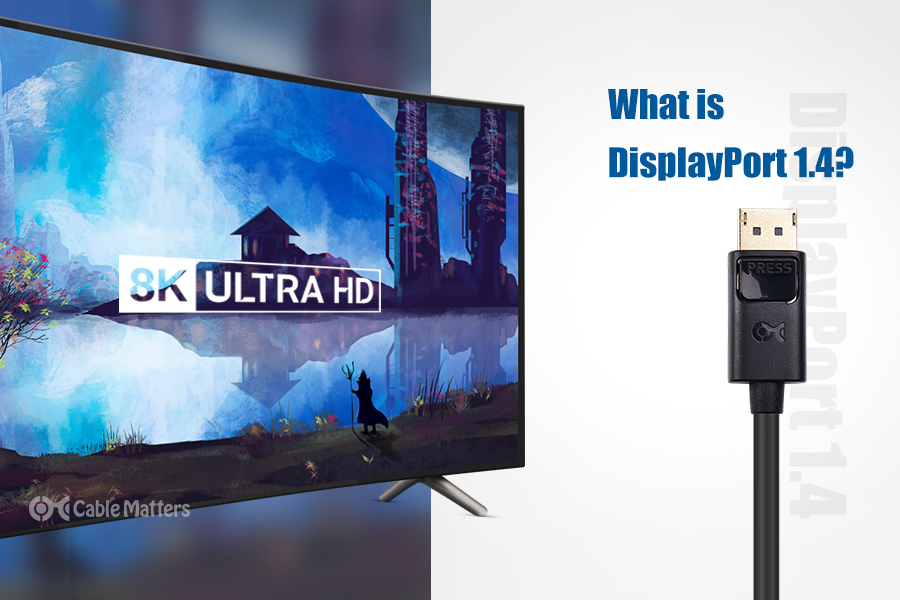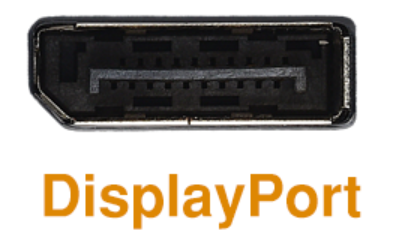
Navigation
For years, DisplayPort has been the preferred high-end data and audio connection for gamers and workers running monitors at resolutions and high refresh rates, like 4K at 144Hz. With a higher data rate than HDMI 2.0, it's been far better at handling more complicated data streams, and that remains the case in 2022. HDMI 2.1 might be able to compete, but supporting devices are still hard to come by since they are limited to high-end GPUs and displays.
There is a new DisplayPort standard in the works too – DisplayPort 2.0 – but aside from that, DisplayPort 1.4 is the best you can get. While it might be a standard that's several years old, it still has one of the best features and spec lists you'll find among any connectors. Only the supremely modern alternatives can stand up to it and even hope to compete.
What is DisplayPort 1.4?
DisplayPort 1.4 is a digital display interface developed by the Video Electronics Standards Association (VESA). The DisplayPort 1.4 standard was first published in March 2016. While it didn't introduce any new transmission modes and did not increase the available bandwidth or data rate, it maintained the strong showing from DisplayPort 1.3. DisplayPort 1.4 has a maximum total bandwidth of 32.4Gbps and a maximum total data rate of 25.92Gbps. That gives it enough bandwidth to handle a 4K UHD stream at up to 120Hz with 24-bit/px color, or a 5K display at up to 60Hz, with 30-bit/px color. It even supports 8K video, but only at up to 30Hz due to the hefty bandwidth demands.
The DisplayPort 1.4 connector looks similar to a USB port but is slightly larger and has a distinctive shape with one corner cut at an angle, making it easy to identify. It's designed to securely fit into the port, ensuring a stable connection, and often has a latching mechanism to prevent accidental disconnections.

Using DisplayPort 1.4 is straightforward. You simply connect one end of a DisplayPort cable to the DisplayPort output on your computer or gaming console, and the other end to the DisplayPort input on your monitor or TV. If the device is powered on and set to the correct input, the screen should display the video signal without needing further setup.
DisplayPort 1.4 plays a significant role in various scenarios where high-resolution video and audio transmission is essential. Gamers heavily rely on it for its capability to deliver smooth, crisp visuals that can keep up with the rapid pace of modern gaming, providing an immersive experience free from stutter and lag. This same high performance is why it's a staple in the arsenal of professionals like graphic designers and video editors, where precision and attention to detail in imagery are non-negotiable.
DisplayPort 1.4 is also commonly used in office and educational settings for connecting computers to projectors or monitors. This is due to its compatibility with high-resolution displays, allowing for clear presentations and content sharing. In essence, DisplayPort 1.4 is a versatile, high-performance connection that serves a wide range of applications from gaming and entertainment to professional and educational uses, making it a go-to choice for those who need reliable, high-quality display solutions.
DisplayPort 1.4: Benefits and Advancements
DisplayPort 1.4 offers several benefits and advancements that make it a sought-after display technology. Released in March 2016, DisplayPort 1.4 has a maximum total bandwidth of 32.4Gbps and a maximum total data rate of 25.92Gbps, allowing it to handle demanding resolutions and refresh rates. One of the most important features of DisplayPort 1.4 is the introduction of Display Stream Compression 1.2 support (DSC), which enables visually lossless encoding for higher resolution and HDR content. This means that with DisplayPort 1.4 and DSC, it is possible to support 4K at up to 120Hz with 30-bit/px color and HDR-enabled, or 8K at up to 60Hz.
Additionally, DisplayPort 1.4 provides support for Dual-mode DVI and HDMI adapters, allowing users to connect HDMI or DVI displays to a DisplayPort source. It also offers better support for HDR10 metadata and forward error correction (FEC), ensuring a noiseless transmission. With these improvements, users can enjoy enhanced visual quality and seamless connectivity when utilizing DisplayPort 1.4.
DisplayPort 1.4 also made significant advancements in the audio domain. It raised the maximum audio sample rate from 768kHz to 1,536kHz and increased the maximum number of audio channels from 8 to 32. These enhancements provide richer audio experiences for users who require high-quality sound, making DisplayPort 1.4 a desirable choice for multimedia professionals, content creators, and audiophiles.
Moreover, DisplayPort 1.4 includes features like multi-stream transport (MST), which allows multiple monitors to be connected via a single cable, and forward error correction, which detects and corrects errors to ensure reliable transmission of data.
The interface can also be used over USB-C, providing a single cable solution for video, data, and power, which simplifies the connection of devices and enhances user convenience.
In conclusion, DisplayPort 1.4 offers a range of benefits and advancements that make it an attractive display technology. With its high bandwidth, support for DSC, improved compatibility with adapters, and audio enhancements, DisplayPort 1.4 is a preferred choice for users seeking high-resolution, high-refresh-rate displays with superior audio capabilities.
Should you buy DisplayPort 1.4?
DisplayPort 1.4 is currently the most sought-after DisplayPort technology. But you may be asking yourself, is DisplayPort 1.4 worth it? Do I need DisplayPort 1.4?
The answer to those questions is mixed because it depends on your particular use case and needs. If you can benefit from the advancements made with DisplayPort 1.4, like the introduction of DSC 1.2 and the expanded audio channels, then it's worth opting for, even if it costs a bit more.
If you're a more typical user looking to play games, watch movies, or work on a display at just 60Hz, DisplayPort 1.2 is perfectly fine. Some of the best monitors available today are still based on that slightly older standard and they don't suffer for it. DisplayPort 1.2 offers a bandwidth of 21.6 Gbps compared to 32.4 Gbps on DisplayPort 1.4, but for casual users, that is more than enough. One major downside to DP 1.2 though is that it does not support HDR.
That being said, if you’re a user looking to do some high refresh rate gaming (120Hz and up) or high-resolution video editing, you’ll want to utilize DisplayPort 1.4’s 32.4Gbps bandwidth capabilities. You’ll need to make sure that all equipment (monitor, source, and cable) supports DisplayPort 1.4. Luckily, DisplayPort 1.4 cables are similarly priced to DP 1.2 cables so picking one up is easy enough - just take a look at the product specifications. Most DP 1.4 cables will market a maximum resolution of 8K, while DP 1.2 cables will market a maximum resolution of 4K. Also, remember that DisplayPort 1.4 is fully backward compatible with 1.2 so having DP 1.4 cables at the ready is an excellent way to future-proof your setup.
Make sure you're buying your DisplayPort 1.4 cables from a reputed source like Cable Matters. Most of the DisplayPort cables that Cable Matters offers are VESA Certified which means they've passed the Video Electronics Standards Association's rigorous testing requirements. There, you'll find plenty of choices, whether you want shorter, passive DisplayPort cables, or longer, active alternatives which can stretch up to 24 feet. Take a look at some of Cable Matters' cable offerings.
What about DisplayPort 1.4a?
DisplayPort 1.4a was ratified in April 2018 and is a minor alteration of the DisplayPort 1.4 standard that did nothing to improve its bandwidth or feature support for video or audio streams. The only change is the implementation of DSC 1.2a, which improves upon DSC 1.1 and 1.2 with better support for HDR in the compression algorithm and improves color support.
DisplayPort 1.4a distinguishes itself from the earlier DisplayPort 1.4 standard, most notably through its universal support for Display Stream Compression (DSC) 1.2a across all of its ports. This is a critical distinction because, while DisplayPort 1.4 introduced the capability for DSC (up to version 1.2), not all ports built to the DisplayPort 1.4 specification necessarily support DSC. In contrast, every port conforming to the DisplayPort 1.4a standard is required to support DSC 1.2a, ensuring a more consistent feature set across devices and applications.
This universal support for DSC 1.2a in DisplayPort 1.4a transforms the user experience, especially in terms of handling High Dynamic Range (HDR) content and improved color representation. DSC 1.2a's better support for HDR and color allows for efficient compression that retains the quality of the visuals, ensuring that users can enjoy enhanced gaming, movie watching, or design work with no compromise on color accuracy and visual fidelity.
Moreover, the mandatory support for DSC in DisplayPort 1.4a simplifies the ecosystem—manufacturers, integrators, and end-users no longer need to decipher the level of support for compression across different devices. This change means that devices equipped with DisplayPort 1.4a are guaranteed to handle high-resolution, high-fidelity content more effectively, providing a reliably high-quality experience across displays and systems.